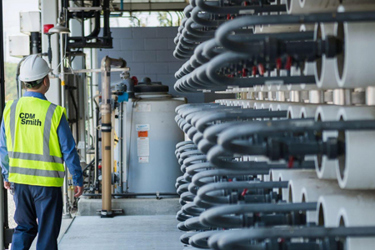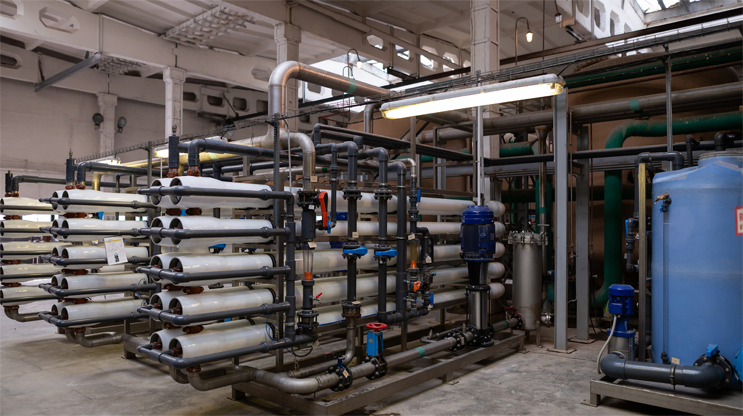The Benefits And Challenges Of Desalination
By Rubén Muñoz

Leaning on a wealth of experience, an engineer lays the groundwork for successful, cost-effective desalination projects.
Communities are expanding their water supply portfolios to address water scarcity driven by population growth, extreme weather, droughts, and urbanization. As freshwater limitations increase, the demand for brackish and seawater desalination is expected to rise. However, significant hurdles — such as high costs due to energy demands and environmental concerns — hinder the widespread adoption of desalination.
A Road Map To Successful Projects
Based on lessons learned from desalination projects over the last decade, including the Aqaba-Amman Water Desalination and Conveyance Project in Jordan, CDM Smith has developed a road map from concept through procurement.
We identified five major steps in this road map:
- Diagnosis. This initial phase involves performing a water balance to identify the water deficit and generating emergency plans and water usage restrictions.
- Planning and development. We establish a clear definition of the water deficit and impacted areas. This phase also includes addressing brine management solutions, understanding permitting needs, and coordination with local energy providers.
- Pre-feasibility study. This phase focuses on selecting a location for the desalination plant. To develop this task, we determine the capacity of the plant as well as a phasing strategy based on a water demands study, then produce a conceptual process solution to generate inputs used to perform the trade-off for the optimum project location. We use multicriteria analysis (MCA) supported by geographic information systems (GIS) tools incorporating variables such as land use, right of way, local communities, intake and outfall solution, marine environment, power supply, product distribution, and connection points. In this stage, we screen various project locations and rank them using MCA to select a preferred location.
- Procurement strategy. This step outlines project delivery options such as progressive design-build (PDB), publicprivate partnerships (P3), build-own-operate-transfer (BOOT), or build-operate-transfer (BOT) methodologies, and strategies to select the best collaborative delivery approach for the owner and funding partners.
- Site and environmental evaluation. Discharge permitting is one of the most critical activities in seawater desalination projects, which requires a marine baseline study including seawater characterization, marine current, winds, and bathymetry. Best practices include treating the chemicals and waste utilized in the pretreatment process, such as filter backwash. Postconstruction testing is typically required to demonstrate compliance with a brine monitoring plan that is submitted during permit application. Typical parameters include flow rate, conductivity, temperature, pH, oxygen, and chlorine. After approval, this process allows the construction of the desalination plant to begin.
Cost Considerations
Factors that influence the construction cost of desalination plants include the seawater intake and outfall, location of the plant, power supply connection, brine management and disposal, environmental regulations, and water quality. The intake and outfall are a substantial portion of the cost of desalination projects. The best location for intake and outfall can be determined by studying various construction methods for the intake capacity, specific site conditions, and environmental permitting restrictions.
In small to midsized capacity plants, it is feasible to install a sub-surface solution using beach wells and slant wells, which are the most sustainable way to extract seawater. We designed a new facility for California American Water’s Monterey Peninsula Water Supply Project that includes a slant well for seawater intake.
Large international desalination projects, like the Spence Growth Options project, use various delivery, financing, and operation models. For example, BOT is a concession model whereby a private entity or special purpose company assumes the responsibility for project execution, project finance, and long-term operations. At the end of the concession contract, it can be renewed with the special purpose company, or the asset can be transferred to the owner. Additional desalination initiatives using BOT and P3 are currently under evaluation. There are also several projects in the design phase being implemented as PDB and receiving state and federal funding that do not involve private entities.
Renewable Energy
Desalination plants require substantial energy to operate, and renewable energy would normally be preferred for environmentalimpact considerations. The main challenges of implementing renewable energy, such as wind or solar, at desalination facilities is that the generation is not constant, and the best locations for generation are not necessarily close to the desalination plant. This means that renewable energy cannot supply the desalination plant continuously, unless costly energy storage solutions are employed.
When renewable energy cannot be implemented as part of a desalination project, many plants are connected to local power grids. To offset emissions and environmental impacts, projects can incorporate energy recovery devices; solar panels; LED lighting; higher efficiency motors; carbon offset credits; high-efficiency, high-pressure pumps; efficient membrane configurations; and load-shifting strategies to reduce the strain on local power supply.
Brine Management
The seawater desalination process creates a brine that has approximately two times the salinity of raw seawater. The most cost-effective solution is to discharge it back to the sea using brine diffusers, with criteria defined during permitting application using a brine dilution model. For example, the most restrictive standards require compliance with a 2% increase in salinity compared to ambient at 100 meters from the diffuser, which is feasible to achieve during operation and compatible with the ambient salinity tolerance of marine species. We have applied this approach successfully at facilities in the Middle East, Australia, and Latin America.
For brackish desalination applications that require inland disposal, we have used deep infiltration wells or evaporation ponds. We have also implemented minimal liquid discharge (MLD) using higher recovery technology like closed circuit reverse osmosis (CCRO) to reduce brine volume and produce more permeate.
In seawater applications, a brine mining process using combinations of nanofiltration membranes, reverse osmosis (RO), and high-pressure RO (HPRO) and counter-flow RO (CFRO) for concentrate streams has been tested and can achieve recovery of 65% and concentrate up to 200,000 mg/L of total dissolved solids. This application has great potential for economic feasibility depending on the market value of the minerals extracted from brine; currently, the technology is proven at pilot scale but not yet implemented at full-scale plants.
Pretreatment
Large existing desalination projects producing more than 200 MGD with open intakes and relatively good water quality, i.e., total suspended solids (TSS) of under 5 mg/L, utilize one stage of pressurized multimedia filter to reduce footprint and optimize cost. Midsize existing desalination plants of 5 to 30 MGD use an ultrafiltration process to further reduce footprint and civil works, but along with that come greater operational costs. Of course, the pretreatment selection needs to be based on specific raw water quality in terms of TSS, turbidity, total organic carbon (TOC), algae-bloom risk, and estimation of lifecycle water cost. Open intake with water quality challenges will require intensive pretreatment with coagulation/flocculation, dissolved air flotation, or clarification, which increases capital cost significantly. One way to optimize this is to assess various treatment configurations and leverage pilot plant data to determine actual operational performance in specific locations.

Leveraging Reverse Osmosis Solutions
RO technologies are rapidly progressing with new developments and innovations that decrease costs and increase efficiency. Recent technological advancements include:
- Modular solutions. One way to reduce costs is to apply modular preassembly solutions for RO skids. Main components can be prefabricated offsite in a controlled environment, ensuring high-quality products. This reduces the risk of project delays, because prefabrication activities can be done in parallel with civil works and reduce installation costs onsite.
- RO configurations. Special optimized configuration includes a pressure center with a dedicated common set of large, high-pressure pumps to feed several RO skids. Large pump capacity can achieve higher efficiency.
- Decreased energy consumption. Development of new membranes with higher productivity allows us to optimize the flux distribution by utilizing various membranes in the pressure vessel, with high rejection in front and high productivity in the rear positions, thereby decreasing energy consumption. Restricted limits for boron and bromide require a certain technology trade-off to select the optimum configuration by analyzing one-pass configuration with high-rejection membrane versus partial, second pass with variable permeate split. The permeate split application with a second pass allows us to optimize the size of the second pass and adapt the process to variations in salinity and temperature.
- New development of energy recovery devices with higher capacity. The increase of 30% in energy recovery devices allows a compact design with fewer pressure exchange elements and less mixing, which reduces energy consumption compared to previous models.
- Dry membranes. Usually, membranes come with a solution to preserve them during transport and storage, but newer membranes can be shipped “dry,” which allows a longer storage time and reduces installation time during commissioning phase.
Desalination presents a viable solution to address water scarcity from freshwater sources. While desalination provides substantial benefits, it also presents challenges, such as high costs driven by significant energy demands as well as environmental impacts. However, advancements in RO technology and effective brine management practices can help control costs and improve efficiency. By leveraging these practices, communities can navigate the complexities of desalination and contribute to sustainable water management.
 About The Author
About The Author
Rubén Muñoz is a civil engineer with 17 years of experience in engineering water supply infrastructure and desalination projects. As the discipline leader for desalination at CDM Smith, Rubén focuses on the planning and design of marine works, desalination plants, hydraulic conveyance for pipelines and pumping stations, and RO plants.
